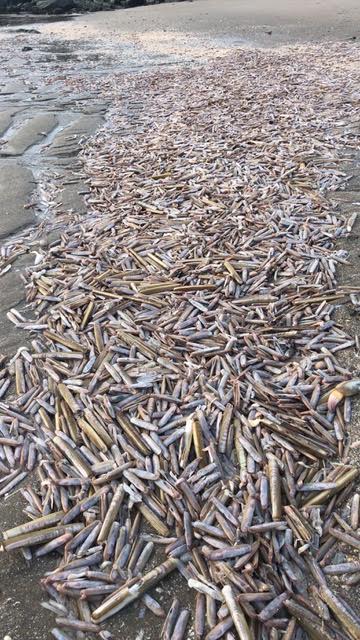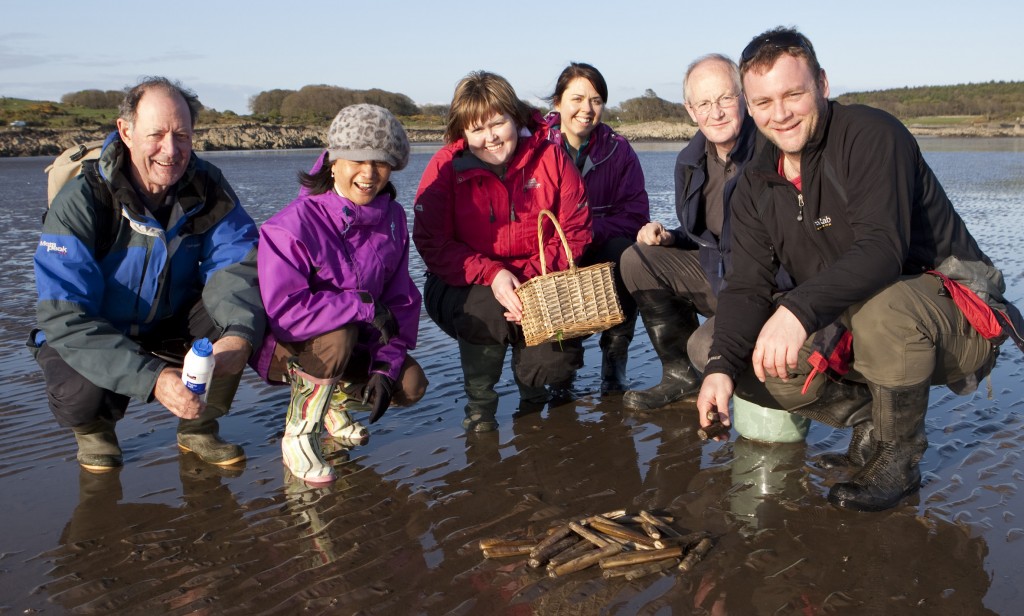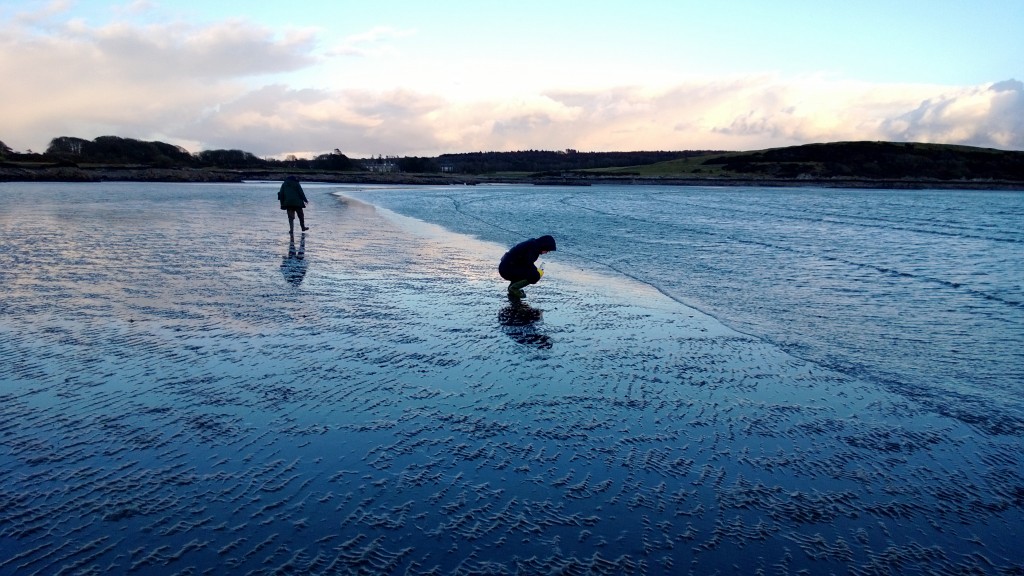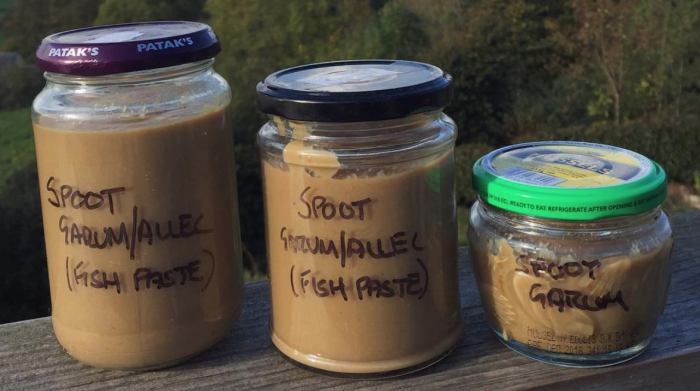Razor Clams/Spoot Clams – Edibility, Identification, Distribution, Ecology and how to catch and cook them
A fun video of me catching spoot clams with the help of my hound! (Recommend volume up 🙂 )
AKA Razor Clams – Predominantly Ensis arcuatus around the UK, but there are a few subtly different, but equally edible varieties even around the UK, notably Ensis ensis, but also Ensis siliqua, which is less curved.
I love all shellfish and spoots are one of my favourite. The sweet succulence of their flesh falls deliciously between scallops and squid. As with many wild foods, the manner by which they are foraged enhances their gastronomic qualities. Being out in the wide expanses of a sand flat at twilight watching your first spoot lurch mistakenly (and a little rudely) from its silty burrow is one of the great foraging experiences. Children of all ages will be transfixed. Though you will have to actively seek them out, there is, for once, no danger of misidentification – not much else lurks beneath the low tide sands in a cut-throat razor shaped shell.
CHECK THE FORAGING EVENTS CALENDAR FOR GUIDED SPOOT FORAGING DATES or contact mark@gallowaywildfoods.com to arrange a low-tide foraging trip
Commercial Harvesting of Razor Clams
You are unlikely to find razor clams from UK waters commercially available. The traditional, and environmentally catastrophic practice of dredging (or bottom dragging) for them is not permitted in UK waters (though sadly all sorts of other dredging is still legal).
In the last 20 years or so electro-fishing for razor clams, by means of passing a low electric current through the sea bed to force them from their burrows before harvesting by (a diver’s) hand, has become common. While certainly lower impact than dredging (what isn’t?!), the jury is still out on the impact and sustainability of the method. Personally I have never noticed any ill effects from electro fishing in the areas that I visit (though neither have I seen any electro-fishing taking place there), but coast-lovers in other areas of SW Scotland have reported large quantities of dead crustaceans being washed ashore after the presence of electro-fishers.
Whatever razor clams are caught – by fair means or foul – around the UK, you are unlikely to see them for sale in fishmongers. They command a huge price in Japan and other more seafood-savant nations, so the vast majority are sold abroad. High end restaurants are the most likely place you’ll encounter them for sale in the UK.
Harvesting a few for your own consumption strikes me as the nicest and least problematic ways to try a few of these delicacies – and the process of catching them is just about the most fun you can have with your clothes on!
With a little bit of research, some planning and the right equipment, spoots are not hard to come by. You will first need to identify a low spring tide – which normally occur a couple of days after a full moon (“spring” here refers to the elasticity of the tide, not the time of year, though the lowest do occur in March). You can get them when the tide isn’t so low, but not so many or so easily.
Like all shellfish, spoots should not be collected during the summer, when they are spawning, and water temperatures are higher, bringing greater risk of shellfish poisoning. Avoiding months without an “R” in them is a decent rule of thumb, though around my way they are pretty hard to catch even on big autumn tides, and I see them predominantly as a spring food.
Next you should equip yourself with salt – either a plastic tub from which dry salt can be accurately dispensed, or a strong solution that can be squirted (serious spooters use pump dispensers of the type used for spraying garden weedkiller). You will also require a good pair of wellies and a bucket the size of your optimism.
Once suitably equipped and with the tides in your favour, you must select your hunting ground. Lots of empty shells washed up on the beach is an encouraging sign, but remember that waves and tides don’t always move debris directly in and out. Generally, beds of fine sand of the type exposed in most of Galloway’s sandy shores are worth a look, though different sub-species thrive in different grades of grit and shingle. A certain amount of trial and error is necessary – and patience as you may only get the chance once or twice a month.
When you have selected a likely time and place, head out over the large expanse of exposed sea bed. This is an area that looks like a barren wet desert, but is actually teeming with life beneath the silt and sand. The further out you can go, the better the hunting will be.
If you are in a good spot, you should soon be alerted by small “spoots” of water being shot out of the sand – normally on the very periphery of your vision. This is the clam taking evasive action at the thunder of your foot-falls. Often they are slow to react, and don’t actually start their downward journey until you lift your foot. For this reason, walking backwards will actually increase your chances of seeing a spoot spoot!
Their “default” feeding position is at right-angles to the sea bed with their “mouth” end flush with the surface. As they flee, they move rapidly downwards, and, in the fine silts of the Solway and Wigtown Bay, any digging on your part is likely to be fruitless – or mangle the clam beyond edibilty. In coarser sands off Orkney and Lewis they burrow more slowly and it is often possible to plunge your hand and grab them as they retreat. But even in these areas many will evade you. This is where your salt comes into play.
Keep your eye on the source of the “spoot”. You should be able to discern the clam’s escape route in the form of a small crater (sometimes this can look like an elongated 8). Liberally apply you salt and wait. If both your salt and the sand are dry, it may help to wash your salt down the hole with some sea water. You should soon see pulsing movements of wet sand in the crater. This is the exciting bit – for the first few hundred times anyway! Eventually, the clam should magically, and quite rudely, emerge. Don’t get panicked into grabbing them as soon as they put their head above the parapet – they could easily slip from your grasp. Even if they seem to be retreating again, have faith! They move by pulsing motions in a two steps forward, one step back kind of way, and almost always fully emerge given time. Check out this video at the top of this post to see the process in action.
This is even more exciting for children and should give them the foraging bug for many years to come. My earliest foraging memory is hunting for shore crabs on Arran. My parents loved it because my siblings and I could entertain ourselves for weeks with 20 square metres of beach and a bucket. Of course, we had no notion of eating the crabs – finding and tormenting them with lollipop sticks was pleasure enough…
A friend of mine from Shetland sneers a little at the salt method. It is seen as a wee bit “soft” up there and anyone turning up at low tide with salt will get sideways glances. Their technique is a much fairer contest whereby you creep up on their burrows and cut a long-bladed knife through the sand until it makes contact with the fleeing mollusc. Keeping a sideways pressure against the shell will stop its flight and you should be able to root them out quite easily. It certainly isn’t as easy as the salt method, but is ultimately more satisfying – but only once the novelty of seeing them erupt has worn off.
Sporting Spooting, aka Mollusc Wrestling
I have developed a technique which allows me to look down my nose at even the Shetlanders. I call it sporting spooting or mollusc wrestling. It requires launching your finger down a burrow when you see the spoot, and arresting the clam’s downward journey by pressing hard in a sideways direction with the tip of your finger. Next, wrestle your thumb in until you can pinch the top of the shell. From there it is a battle of stamina – the clam pulling down with all its (not inconsiderable) strength, while your hand and wrist locks into a spasm. See me demonstrating this ancient and noble art here:
Different subspecies of razor clam can behave differently. In our finely silted estuarine waters around much of Galloway, they dive very quickly indeed. In contrast, I find them much easier to get by hand in the more granular Atlantic sands off Lewis. Interestingly spoots that grow in more grainy sands tend to develop a slightly tougher end to their foot to help them burrow.
Sustainable Foraging of Razor Clams
If you have managed to locate a healthy colony, you should be able to gather a good number before the incoming tide spoils your fun. Try not to get carried away in the excitement of it all and take more than you can use – remember, they are shellfish and have limited fridge-life.
On the right tide at the right place razors can be found in vast quantities. Around areas of Galloway many miles of of tidal flats burst with spooting spoots as you walk along them. Most of them don’t even get uncovered at low spring tides, so it is highly unlikely that even thoughtless greedy foragers (if such a thing exists) could make any significant impact.
The phenomenal abundance of razor clams in my area of SW Scotland – and the natural challenges they face – was made clearer to me after an unusual combination of a very low tide and very low temperatures. I’ve made this short film about it:
After making that video, someone sent me the photo below that was taken not far from my filming location, and several days earlier. The spoot clams in the photo were all still alive at the time. Had I encountered this, I think I would have ended up borrowing them back out on the next low tide and poking them back into their silty beds – and maybe a bucket full for my freezer…

Mass stranding of live razor clams after an unusual combination of conditions, Galloway, SW Scotland. It is likely that currents and the incoming tides aggregated the shells to this location. Image courtesy of Mark Mckillop.
Whatever the challenges – both natural and commercial – faced by razor clams, the nimble palates and flexible appetites of foragers, combined with their embodied intimacy with the natural world, leave them well placed to be responsive to both gluts and scarcity.
Whatever amount of spoot clams you catch, I recommend putting the smallest 75% back. This means you don’t have to work out which sub-species you have been catching (each matures to a different size), so you can be sure you aren’t catching immature specimens. Be sure not to leave them stranded and at the mercy of the birds and sun if the tide is still retreating – toss them just beyond the low tide mark near where you caught them and they will burrow back into their silty mattresses.
Safe Usage of Razor Clams
In my experience, unlike most other filter-feeding bivalves, provided they have been harvested from clean waters, spoots do not require purging or depuration. I say this as somebody with a fairly robust constitution, who likes a lot of his shellfish as close to raw as possible. Some people might advise you to purge (24 hours in clean salt water) and thoroughly cook all molluscs before eating. I have never had so much as a wet fart from any seafood so am perhaps a little more relaxed than most. You should make your own mind up on this issue.
I recommend you prepare and eat or freeze your razor clams as soon as possible after catching, though they will stay alive in the fridge for several days (though all the while losing weight). The meat, once removed, is actually improved by freezing – which makes it even more tender.
I rinse them of sand and silt, then eat them raw, with perhaps a sprinkle of fresh pepper dulse and dried sea lettuce, maybe even wrap them in a wild garlic leaf. If you really feel you must cook them, briefly steam them open (30 seconds should be enough – they are ruined by over cooking), then rinse them again.
The meat and gubbins should then come easily away from the open shell. The only part not recommended for eating is the darker coloured stomach, though the mouth can be a bit chewy. The “foot” is the “choice cut” – tenderest and sweetest. I can never resist eating some raw and wriggling on the shore. They taste like very fine, extra sweet squid and lend themselves to similar preparations such as marinading and stir-frying, or both. Cooking – if you must – should be kept to a bare minimum. They make superb sushi or sashimi. Roll with wild garlic, wood sorrel, cuckoo flower for a real gastronomic treat.
I developed my Scottish dashi broth recipe specifically to appease people on my coastal forays that couldn’t face them raw and wriggling. Spooning hot dashi broth over very lightly poaches them and provides a startlingly umami-heavy experience.
How to Make Spoot Clam Offal Garum
I use all the less choice cuts to flavour fish stock, or ferment them into garum – a salty condiment. The closest reference point most people will have to this is likely to be the fish sauce used in Asian cookery, though it is actually a preparation most associated with Western Mediterranean cookery, and predates the Romans. In UK cuisine, Geo Watkins Anchovy Sauce is the closest you will find to it commercially. XO sauce and even Worcester Sauce also use fermented fish to create pungent umami along these lines.
Garum is very pungent, and not for the feint hearted. It is salty enough to use to spark further ferments and adds extraordinary fruity and super funky notes to fermented wild garlic. I have also made a passable garum with fungi. I also use it to season and add umami to meat stews and barbecued meat and shellfish.
The basic process with spoot clam offal (or any fish trimmings, including the guts – in fact especially the guts, as they contain enzymes that improve the fermentation), is to blitz/pound/stir them with about 20% by weight of sea salt, then leave them to ferment for about 6 months, stirring occasionally. Its a smelly process, and the end result is not for timid cooks. But used judiciously it is an amazing seasoning.
Related Posts:
- Browse more forageable beasties…
- Mushroom (dryad’s saddle) garum
- Wild Sushi
- Seaweed dashi broth
- Seaweed guide













29 Comments
Great post mate. Never heard the ‘Spoot Clam’ name before. I think i prefer it.
cheers
Thanks Tom. It is a good name – peculiarly Scottish I think, but no reason not to spread it further afield…
The name spoot originates from the Western Isles and means spout ie they spout out the water. I learned this from an old fishermans wife when I holiday’d in Lewis many years ago.
Fabulous – thank you so much: I shall be salting away at the Nairn beach either in the autumn or more likely in the spring. These things always fascinated me, knowing they were delish but I had and ex-husband who refused to eat them as -“they look like dogs’ willies”… However, ignore the ignoramus. Your info on pepper dulce and sea lettuce is excellent and is shall immediately get those on tomorrow morning’s beach walk. Thank you! xx
Spoots are cool! Lovely fried with finely chopped bacon. I think the name “spoots” might originate in the Northern Isles.
Great post Mark
Love the video. Have eaten them often, usually abroad but never foraged locally for them. I haven’t lived! Must try at home.
I live in Oregon, USA, Check out our razor clams. They are very American. Fat around the middle.
http://www.clamdigging.info/#Anchor-Orego-4928
We have them here in Scotland as well but I think we know them as Quahogs. Delicious
HELLO !!! Great info here 🙂 thank you & Happy 2016!
I’ve been seeking these bivalves for a few years now.
I was told by a Greek fisherman that they make good sturdy fishing bait but he did not add that they are eatable nor that I must seek them out in low tide in the mornings.
Thank you again … I’m off to another quest
Irene
Good luck!
I meet quite a few fishermen catching them for bait when i’m out spooting. They can’t believe I eat them, and I can’t believe they don’t! There are lots of lovely fish out there, but none are tastier than spot clams!
🙂 I’m interested in all the wonderful items and information you are sharing with us! It’s pleasure reading your blog whether it’s about botany or marine life.
I wish I was there (Scotland ) to try spooting razor clams myself! 🙂 – haven’t spotted any such mollusks on this side of the mid – Atlantic coastlines.
The little island on the Aegean ( Chios) where I hail from … there we have a good variety of marine life as well as rare & wild botanicals.
Thank you again 🙂 Stay warm! (We are in the midst of a snow blizzard here in Washington)
Hello Mark.
After having a bit of a time finding out about Arsesmart, I found out that your recipe actually sounded quite delish, as well as funny, at least from the origins of the name.
Much more boring in my lang, but nonetheless a bit of a challenge for a chili-connoisseur like myself.
I love your page to bits, and wish you tons of spare time to research all those wonderful nibbles all around us.
Cheers.
Tom
Thanks Tom, glad you like it.
Sadly, i’m finding less and less time to spend on the website, though I never stop playing and exploring. 🙂
Mark.
How long does it take the razor clams to die after being pulled out?
Hi Karen, That depends on what you do with them. Like all shellfish, they taste better the sooner you kill and eat them. I eat most of mine within 30 minutes of catching. The rest I shuck and kill straight away, or put straight into the freezer, which seems to be accepted as a humane means of killing them, and also tenderises the meat. Steaming as soon as you get them home is another way to go. As far as I know, commercially traded spoot clams stay alive for up to 1 week, provided they are stored correctly, though I wouldn’t reccomend that for the clam’s or the eater’s sake!
Love, love, love razors. We use a pop bottle with a hole in the lid and sea water. Great excitement & lots of giggling guaranteed!
Hi we up galloway end of October and was wondering what’s the best tide size to go out razor calming.we might try sand head or if you got a better beach you could try would be appreciated. Many thanks karl.
I don’t usually find the tides to be low enough in October for this. But if you pick the lowest tide and have a go, who knows, you may get lucky. Happy hunting, Mark
Hope your choice of footwear is appropriate for these excursions, Mark. I’m down that way quite often fishing for bass and I keep meaning to book myself on one of your events!
https://www.amazon.co.uk/Sandy-and-the-Spoot-Boots/dp/0952429608
I find your articals most interesting on razor clam foraging, and I will be up in Ayr at Craig Tara in September, just wondered what the foraging will be like in that area at that time, waiting in anticipation.
Foraging is good anywhere with any wild green space – but especially at the coast. Plenty sea buckthorn at Craig Tara. No idea about sports there.
Glad I’ve found your page, cheers for doing it.
I’ve been looking here on East coast, just pouring salt …. Scunnered, like a dunderheid. Glad to hear it’s not the right season, or even a particularly low tide.
When it is the right season & the right tides, I’m guessing there might be some if it’s an aftanoon low tide, or do you recon I would be just pouring sand like a loon again? ;+)
Well…there are quite a few variables…main one being, are sports actually present at that location? If they are, it becomes a matter of timing. Not sure there is much I can add to what i’ve already shared in the post! Good luck. 🙂
Does anyone know of any decent hotspots for spoots on the moray coastline. I’ve been trying without much luck : (
Dear Mark
I caught some spoots last night, plunged them for a second into boiling water and then quickly under the cold tap, but the flesh was quite rubbery. I just poured melted garlic butter over them and didn’t cook them any more. What did I do wrong?
beverley Vaux
Cooking them at all seems like an error to me. They are best raw imo. As mentioned in the blog, the most I cook them is very quick, right at the end of making a start fry (literally warming them through), or dropping the meat into dashi broth just before eating.
Brilliant and helpful article!
Just so you know though, Ensis magnus and Ensis arcuatus are actually the same species. E. arcuatus is an old synonym for E. magnus that is no longer accepted but gets thrown around a lot still!
Great post! Thanks for sharing.
I checked Prestwick beach is classified as class A area.
Do I need to apply for any licence if I want to harvest razor for self use by hand?
No, not for personal use, in Scotland.
Mark